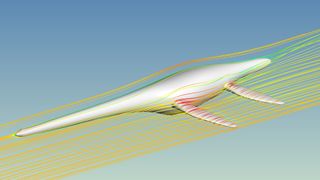Giant 'sea monsters' evolved big bodies to offset long necks being a total drag
However, having a large torso helped streamline their swimming.

Scientists have discovered that having a large body provided a much-needed mobility boost to extinct marine reptiles with long necks.
The new research, which debunked the long-standing idea that there's an optimal body shape amongst marine animals to make their bodies more streamlined underwater, found that an animal's body size is actually more important than its body shape when it comes to the energy economics of swimming.
For the study, researchers at the University of Bristol in the United Kingdom looked at a number of different extinct tetrapods (four-limbed vertebrates) that lived during the Mesozoic era (about 252 million to 66 million years ago). Tetrapods on the scientists' list included the ichthyosaur, whose torpedo-shaped body resembles that of dolphins, and Elasmosaurus, a genus of plesiosaur known for its four large flippers and a dramatically elongated neck that helped it capture quick-moving prey.
While the researchers found that having a longer neck did create some drag when swimming, having a larger torso helped compensate for this loss, according to virtual 3D models they created of these ancient animals.
"We foresaw that size would have a big impact, but we didn't expect to find this interplay between neck size and body shape," said Susana Gutarra Díaz, a paleobiologist with the University of Bristol's School of Earth Sciences and the National History Museum of London, who led the research. "The advantage of having a larger body is having a lower resistance relative to body mass," Gutarra Díaz told Live Science.
Related: Ancient 'Loch Ness Monster' from Antarctica breaks a record for body size
To test the energy demands of swimming across different marine reptiles, researchers created hypothetical 3D digital models using fossils of plesiosaurs, ichthyosaurs and extinct marine mammals; they also modeled modern cetaceans such as common bottle-nosed dolphins (Tursiops truncatus). They then applied data from those models to a computer program to create flow simulations for the different subjects. In other words, Gutarra Díaz and her team built a virtual water tank that customized the aquatic environment with things like water current speed and direction, and measured how different forces would act on each animal.
Sign up for the Live Science daily newsletter now
Get the world’s most fascinating discoveries delivered straight to your inbox.
"In our study we show that large animals have a greater drag in absolute terms, but the mass specific cost of the drag — or the power they need to invest to move a unit of body mass — is smaller," Gutarra Díaz said. "This has to do with how the drag scales with size. Most of the drag in these aquatic organisms comes from skin friction, and therefore depends on the surface area."

As an animal gets larger — provided its general shape doesn't change — the proportion of surface area to mass is reduced, because mass increases at a faster rate than the surface does, Gutarra Díaz explained.
"So, we show that bigger is also better in terms of the hydrodynamic constraints," she said. "In other words, we show why some large aquatic animals can afford to have these crazy shapes."
Whales are a good modern-day example of this phenomena, Gutarra Díaz added.
The study authors were particularly interested in the necks of Elasmosaurus individuals — which in some cases measured 20 feet (6 meters) in length — and so the scientists generated 3D models of Elasmosaurus bodies with varying neck spans. Their simulations revealed that, at a certain point, a longer neck did add extra drag, but having a larger trunk helped cancel that out.
"Our results help us to better understand the evolutionary trade-offs experienced by plesiosaurs," Gutarra Díaz said. "Our simulations show there is a threshold when high drag kicks in, which is a neck length of about twice the length of the trunk. When we analyzed a large sample of plesiosaurs, it was very interesting to find out that most species evolved neck proportions below this threshold. But more interestingly, the plesiosaurs that evolved necks longer than that also had very large trunks that canceled out the drag excess."
The findings were published April 28 in the journal Communications Biology.
Originally published on Live Science.

Jennifer Nalewicki is a Salt Lake City-based journalist whose work has been featured in The New York Times, Smithsonian Magazine, Scientific American, Popular Mechanics and more. She covers several science topics from planet Earth to paleontology and archaeology to health and culture. Prior to freelancing, Jennifer held an Editor role at Time Inc. Jennifer has a bachelor's degree in Journalism from The University of Texas at Austin.
